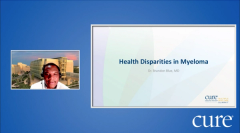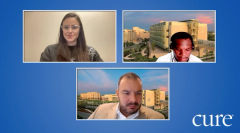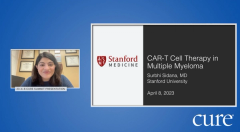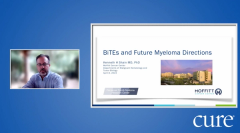
Educated Patient® Multiple Myeloma Summit Disease Overview Panel: April 8, 2023
Watch Dr. Ariel Grajales-Cruz and Dr. Brandon J Blue answer questions about myeloma during the CURE Educated Patient Multiple Myeloma Summit.
Episodes in this series

This panel was moderated by Brielle Benyon, and included Dr. Ariel Grajales-Cruz, a hematologist-oncologist at Moffitt Cancer Center, and Dr. Brandon J Blue, a clinical instructor in the Department of Malignant Hematology at Moffitt Cancer Center.
Transcription:
Benyon: Dr. Grajales-Cruz, can you explain what's the difference between MGUS and FISH testing? And when should each be used?
Grajales-Cruz: So those are different concepts, right? So MGUS, it's a diagnosis of monoclonal gammopathy of uncertain significance. Whereas FISH, it's fluorescence in situ hybridization. It's a testing tool that we use on the bone marrow biopsy. So FISH, it's what both Dr. Blue and I were referring to in terms of the mutations that we're looking for. So it helps us understand whether or not there are abnormalities present at the time of diagnosis, either for MGUS, smoldering (disease), or myeloma will be detected. And that will typically be the driver. So those are kind of different concepts. One is the disease. And the other one is the testing tool that we use to stratify the disease per se.
Benyon: Thank you. And next, Dr. Blue. Can you talk a little bit about if there are any efforts to better understand the disparities that we see in multiple myeloma? And what efforts are being done, importantly, to overcome and fix these disparities?
Blue: Yeah, so, you know, the first step is to identify the disparities. To say, “Alright, these disparities actually exist.” So now what we're trying to figure out is why. Again, I brought it up before, we don't know if this is nature versus nurture. Is there something from a DNA or a biology standpoint to say, “Hey, people of African ancestry, Hispanics, are really having something different about their myeloma.” Or is it the environment? Is it something that unfortunately we're being exposed to? Is it the food that we eat, or something that's culturally different? And so that's where a lot of the research is now to try to figure out, is it the chicken or is it the egg? Is it the nature or is it the nurture? But again, there's more work that'll be done and more information that comes out all the time. So very important question and more to come.
Benyon: Great. Thank you. And Dr. Grajales-Cruz back to you. We had a question: How often should somebody with smoldering myeloma have a bone marrow biopsy?
Grajales-Cruz: Excellent question. So typically, anybody with MGUS, smoldering (disease) or myeloma, for our purposes, they all should have a bone marrow biopsy at the time of diagnosis to see where they are. The bone marrow biopsy, unless it's on a clinical trial, there is no such schedule, because we only proceed with a repeat bone marrow biopsy at the time of changes.
Let's say that, for example, the patient is undergoing active surveillance every three to six months through bloodwork and urine tests, a yearly imaging study – that that should always be scheduled – and numbers are stable, no lesions in the PET scan, CT scan or MRI, everything is status quo, there is no real role to repeat a bone marrow biopsy.
Now, let's say for argument's sake, that patient that started with a hemoglobin of 14, now the hemoglobin is in the 10s, that's when we should be starting looking at the marrow. What changed? Because when we think about the involvement in myeloma, they will always report like a normal cellular marrow, and cellularity goes down as we age at our rate of 100 minus your age. For example, I'm 40. So 100 minus 40, my cellularity should be 60. That's a normal cellular marrow. If somebody my age has a 20% plasma cell involvement, that leaves plenty of real estate for the marrow to work properly. On the other hand, if my count started going down, that means that the amount of plasma cells are growing and leaving less real estate for healthy cells to grow. And so whenever we start seeing changes in the numbers, either blood counts or renal function, we should reconsider a bone marrow biopsy for restaging. That's in a nutshell, but a yearly imaging study should always be done.
Benyon: Right. Great. Thank you. Grajales-Cruz, what's the difference between next generation sequencing and FISH? And when should each of them be?
Grajales-Cruz: It's different testing, we're looking at different things, right? Because in an NGS it's next generation sequencing versus fluorescence in situ hybridization. And NGS, we use it for two different things, one for (minimal residual disease [MRD])-negativity to see if the clone is present or not, and to identify if any other clones that might be driving the disease are also present. Because a FISH will look at the chromosomal abnormalities per se, right, whether or not there's a transportation layer 14 portion of chromosome one that is missing, etc. But the next generation sequencing, we'll look, take a deeper dive at the mutation per se, is there a BRAF mutation and MEK mutation, etc. And also, it will help us understand if there's an additional clone that we should be aware of. Because you can have myeloma and other disorder, right. So for example, the patient has myeloma and (myelodysplastic syndrome [MDS]), then we'll be more concerned about some other potential drugs that we should not be using in those patients.
Benyon: Thank you. So I'll put this out to either of you, are there any vitamins or supplements that can be used to increase energy for patients with multiple myeloma who are experiencing intermittent fatigue?
Blue: You know, what I tell people is, there's not one vitamin that I would say that is on the market to help with that. But I do think that vitamins and things could potentially be used, but you (have) to make sure that you disclose (any supplements you are taking) to your doctor. So unfortunately, what happens is, is that there's some vitamins and supplements that can actually increase the risk of bleeding. There's some vitamins and supplements that can affect how you break down certain medicines. And so unfortunately, what happens is, is that there's not a lot of communication. And so what we don't know as the doctors sometimes can be very detrimental. And so I would just say, make sure that if you are using a supplement, if you are using a vitamin to please, please, please tell your doctor because it really affects your treatment. …
Grajales-Cruz: And the other caveat that I would add to that is that, remember that those multivitamins are not necessarily approved or controlled by the (Food and Drug Administration [FDA]), right? So you don't necessarily know exactly what's been put in those medications altogether. It can say 1,000 milligrams of vitamin and not necessarily (have that amount). So always take that with a grain of salt. So like (Dr. Blue) said, there's not a magical formulation. Just have good communication with your doctor and try to use the most reputable brands that we can.
Benyon: Great, thank you. And next I'll put this to both of you as well. What is the staging system that people refer to with multiple myeloma, and is it the same kind of staging for patients with smoldering myeloma as well?
Grajales-Cruz: So the staging for multiple myeloma, it's very different to what we're used to in the solid (tumor) world, right? Because what we are talking about, myeloma is a cancer of the immune system, it is a blood cancer. And so we don't have (numerical staging of) 1, 2, 3 or 4 that we have for solid tumors in which (stage 4) is metastatic. Our staging is based on numbers as of now; soon, we're going to have another one. So it's the International Staging System, or ISS, which is based on … two blood (tests) that are done at the time of diagnosis. And we have the other one that is the revised ISS, the revised International Studies System, which includes … another bloodwork that we add to this and the mutations that are found either on FISH or sector genetics – anybody who has the three, what are called “bad players,” translocation for 14, 16 or 17 will be upstaged to ISS stage 3 automatically or if they have elevated LDH, that will be the case as well. So those are the two stages that we use for myeloma.
For smoldering (multiple myeloma), in reality we use the risk stratification there (versus) staging.
Benyon: Fantastic. We'll do one more question and this is going to you Dr. Blue. Revlimid (lenolodomide) and many other cancer treatments in general are very expensive. What can be done about this financial disparity?
Blue: The first thing I always say is, when anyone gets a diagnosis of cancer, it not only affects you, but it affects your family, your loved ones, right? But the good thing is, is that there are organizations that are out there to help.
I would recommend that everyone who has a diagnosis of cancer, or even if you have a diagnosis of the pre-cancer because again, at some point it may develop into cancer, to look at certain organizations. The American Cancer Society is a fantastic organization that basically is not for profit. And they actually have resources for people who get diagnosed. The Leukemia and Lymphoma Society is fantastic. And they basically have resources and money as well, to help. There's also myeloma-specific groups. And that is the International Myeloma Foundation, the MMRF, which is the Multiple Myeloma Research Foundation, they also have resources as well. And HealthTree, which is one of our sponsors, does a fantastic job. So I want to make sure that I shout them out. HealthTree is not only good for resources, but HealthTree also helps with patient support groups, which I think is fantastic.
I know some of the pharmaceutical companies are also helping out as far as sponsorships. But a lot of times the gain in some of this may depend on your income, but the pharmaceutical company, depending on the medication may also be able to help to get subsidized so there's a lot of help out there, whether it be from one of these big nonprofit organizations, whether it be from smaller local organizations, or even from an actual pharmaceutical company themselves. That's always why we try to get people hooked up with our social worker or even our nursing staff, or even some of the doctors themselves, we can potentially help with that if we need to.
Transcription was edited for clarity.
For more news on cancer updates, research and education, don’t forget to














